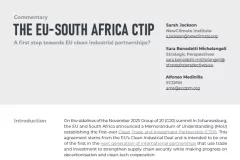
Companies around the world are increasingly alert to the climate emergency, facing calls from a growing range of stakeholders to take responsibility for the environmental impact of their activities. The rapid acceleration of corporate climate pledges means that it is more difficult than ever to distinguish between real climate leadership and unsubstantiated greenwashing.
In this blogpost the lead authors of the Corporate Climate Responsibility Monitor – Thomas Day, Silke Mooldijk, Sybrig Smit – shared their perspectives on questions related to the analysis, and its implications. You can also find a recording of the virtual press conference here.
What is the Corporate Climate Responsibility Monitor?Thomas Day:
The Corporate Climate Responsibility Monitor evaluates the transparency and integrity of companies’ climate pledges. It provides a structured methodology for others to replicate an evaluation on integrity and transparency of companies’ climate leadership. We focus on four main areas of corporate climate action: tracking and disclosure of emissions, setting emission reduction targets, reducing own emissions and taking responsibility for unabated emissions through climate contributions or offsetting.
Why did you set out to do this analysis?
Thomas Day:
Corporates are under intense pressure to demonstrate their climate ambition; the rate of target and pledge setting is unprecedented. Companies are scrambling to identify new and diverse approaches to demonstrating that ambition, and it has become incredibly difficult to distinguish real climate leadership from greenwashing. We wanted to establish more clarity on what good practice entails, and whether companies are really on track.
Silke Mooldijk:
The objectives of the Corporate Climate Responsibility Monitor are threefold: First and foremost, we want to identify and highlight good practice approaches that can be replicated by other companies; Secondly, we want to reveal the extent to which major companies’ climate leadership claims have integrity and are transparent. Thirdly, we aim to scrutinise the credibility of companies’ plans for offsetting their emissions through carbon dioxide removals or emission reduction credits, recognising that voluntary carbon markets are highly fragmented and there remains a lot of uncertainty on credible good practice.
What are the main findings?
Thomas Day:
The key finding is that companies’ net zero pledges are not what they may seem. We found that the headline pledges of 25 of the world’s largest companies in reality only commit to reduce emissions by 40% on average, not 100% as suggested by the terms “net-zero” and “carbon neutral”.
Sybrig Smit:
We see that companies’ headline climate pledges require detailed evaluation and in the majority of cases today cannot be taken at face value.
How did you derive the criteria for your assessment?
Silke Mooldijk:
We based our assessment on guiding principles which we published in the accompanying methodology document. These principles came from a combination of scientific literature review, previous work of the authors, and the identification of existing good practices. These principles represent our views on the most transparent and constructive approaches to corporate climate responsibility, based on our interpretation of the latest scientific evidence and current developments. Within each assessment category the results were aggregated based on their individual importance for the company. The overall rating is the average of the four category ratings. The guiding principles relate to issues where the state of scientific knowledge and debate is rapidly evolving. The goalpost of what constitutes good practice climate action for companies has shifted with the adoption of the Paris Agreement and the increasingly clear scientific evidence that underpins its urgency. With the Paris Agreement global emissions need to be reduced to almost zero, so companies can only claim to be front runners by reducing their own emissions fast and deep. Helping others to reduce was considered viable in the era of the Kyoto Protocol only ten years ago but is no longer sufficient. Guiding principles and corporate climate action need to evolve accordingly.
How did you select which companies to look at?
Sybrig Smit:
We wanted to gain insights from major companies with climate pledges, spanning a broad range of sectors. The selection was not intended to be a statistically representative sample, but rather we wanted to obtain a broad overview of the different approaches being employed across different sectors.
Silke Mooldijk:
We assessed the top-25 global companies according to their annual revenue in 2020, with the following criteria: 1) We only included companies that had committed to high-profile climate change mitigation pledges under one of the main corporate climate action networks and initiatives. 2) To draw insights from a range of geographies and sectors, we limited the selection to a maximum of 5 companies per country (of their headquarters) and 2 per economic sector. 3) We excluded companies in the field of investment management, due to their especially unique circumstances and challenges.
Why did you look at these big corporates only, as opposed to smaller or medium sized companies?
Thomas Day:
The pledges made by these companies, at the current point of the climate crisis, really matter. Major companies with bold climate pledges are highly influential. Their share of emissions and market activity make them obvious role models and linchpins for transformation in their respective sectors and geographies. These companies have the capability, and with that the responsibility, to demonstrate unambiguous leadership. Global decarbonisation objectives could be made or broken by the integrity of their commitments.
Did you find good practices that can be replicated by other actors?
Thomas Day:
Three of the companies we looked at Maersk, Deutsche Telekom and Vodafone, do what should be obvious for a headline net-zero pledge: commit to significantly reducing their emissions in the order of 90-95%. Maersk’s commitment to reduce emissions across its value chain by at least 90-95% by 2040, appears to be an ambitious target for a sector where deep decarbonisation technologies are not yet sufficiently matured.
Silke Mooldijk:
Looking at renewable energy procurement structures, Google stands out. With 80% of its renewable energy consumption stemming from high-quality PPAs and own generation, the company also aims for a 100% hourly match between consumption and local RE generation by 2030. Google therefore recognises the current mismatch and issues that often arise with renewable energy procurement, but also shows ambition and innovation to overcome these. Other companies are looking to follow suit.
Thomas Day:
For setting interim targets, Sony stands out. Although Sony’s commitment to a 100% emission reduction by 2050 includes an undefined role for offsetting, the company uses this longer-term vision to guide the formulation of much more specific short- and mid-term targets. These include emission reduction targets for specific emission scopes as well as other non-GHG targets for activity-specific indicators. Sony’s short-term targets provide a far clearer signal for the implementation of emission reduction measures, than the 2050 target alone would do.
Sybrig Smit:
There are also companies that set the bar high in terms of transparent reporting and disclosure. For example, Sony and Vodafone compile relevant data in a downloadable format, which facilitates a clearer understanding of whether the company is reporting on its full scope of emissions and where the major emission sources are. Some companies go a step further and show current and historical emissions broken down to specific emission sources and a selection of activity indicators reported for certain geographic locations.
Silke Mooldijk:
Engagement with suppliers to address the often very substantial scope 3 emissions also appears to be picking up. Several companies, such as Apple, IKEA, Sony, Unilever and Walmart, have supplier guidelines in place, actively call on their suppliers to set ambitious climate targets, or try to find innovative ways of reducing emissions related to product use. Many of the supplier engagement programmes that we have identified in this analysis were established within the past one or two years.
Maersk is the only company that made it to the “reasonable integrity” category. What is the company doing right, that others do not?
Silke Mooldijk:
Maersk performs especially well compared to other companies on three key elements. First, Maersk does what should be obvious for a headline net-zero pledge: committing to deep emission reductions. The company commits to reduce emissions across its value chain by at least 90% by 2040, which appears to be an ambitious target for a sector where deep decarbonisation technologies are not yet sufficiently matured. The only other two companies to commit to such deep reductions are Deutsche Telekom and Vodafone, both of which depend primarily on the decarbonisation of the electricity sector, where most of the necessary technologies are becoming mainstream. Second, Maersk is making considerable investments in emerging technologies to decarbonise many of its major emission sources, including scope 3. The company is pioneering alternative fuels to replace conventional marine fuels, which currently account for approximately 60% of Maersk’s GHG footprint. Third, Maersk’s integrity has not been undermined by contentious carbon neutrality claims delivered through offsetting, and the company is making climate contributions to support carbon dioxide removals. Still, Maersk could considerably improve on other aspects of its climate strategy, in particularly related to renewable electricity procurement, for which we could identify very limited information. Renewable electricity will play an increasingly important role in Maersk’s climate strategy, as the company transitions toward electric and hydrogen-based technologies for shipping and land-based operations.
What are “quick fixes” for better corporate climate responsibility?
Thomas Day:
Companies need to set clearer and more ambitious emission reduction commitments in the short-term, for the next 5-10 years. Longer-term net-zero pledges have become the focus of corporate climate commitments, possibly because “net zero” as a concept is in trend, but possibly in some cases also because the accountability associated with targets set far in the future is limited. Long-term visions can provide a useful signal, but only when accompanied with adequately ambitious interim targets within a timeframe that requires immediate action. Specific targets over short- and medium-term periods that require immediate action and accountability are of primary importance and should be the main focus.
Sybrig Smit:
Transparency is also key. Companies that make public climate pledges have a responsibility to transparently disclose the information that can back up those declared ambitions. Currently, the quality of disclosure is highly variable; information is often missing, inconsistent or fragmented. Even companies that are doing relatively well are sometimes exaggerating their ambition.
Thomas Day:
Target setting and offsetting claims especially, can be far more transparent. Companies could reformulate their headline pledges to specific and unambiguous emission reduction targets that are not reliant on offsetting or neutralisation of emissions. Current developments increasingly give companies the impression that “net zero” target terminology represents the gold standard for ambition. But this momentum and pressure for companies to commit to net-zero targets could be counter-productive if this creates ambiguity or forces companies into a position of dealing with offsetting or creative emissions accounting. There may be more merit in encouraging companies to set emission reduction targets that go close to zero without implicitly depending on offsetting, and encouraging companies to remain transparent and take responsibility for the remaining unabated emissions through climate contributions without neutralisation claims.
Silke Mooldijk:
With regards to reducing emissions, companies can and should commit to 100% renewable-based energy consumption, but only from high-quality constructs. Most of the companies we looked at already make specific pledges for renewable energy consumption. But approaches like the purchase of renewable energy certificates from old hydro power plants will not lead to any increase in renewable electricity capacity in the system. Only a minority of companies demonstrate high integrity in reaching for higher quality procurement constructs that are likely to have a meaningful impact for emission reductions. We also identified companies that – in stark contrast to their climate leadership claims – did not currently procure any significant amount of renewable energy, nor declare plans to do so in the future. The procurement of high-quality renewable electricity is an accessible measure that should be considered a basic prerequisite for climate ambition.
You state that the companies’ headline targets commit to reduce emissions by only 40% on average, not 100% as suggested by the term “net-zero”. How did you get to this finding?
Thomas Day:
The problem with net zero and carbon neutrality terminology is its ambiguity. The key thing we look for in a target is, whether the company actually explicitly commits to the reduction of its own value chain emissions. Most of them do, but the extent varies widely: some companies commit to reduce the full scope of their value chain emissions by over 90%; several others commit to a much lower emission reduction target, or a seemingly high emission reduction target that covers only a fraction of their emission sources. Where specific targets were identified, we looked at the depth of those targets as well as the coverage of emission sources that they apply to, in order to establish the proportion of the company’s full value chain emissions that the company explicitly commits to reduce, by the target year. The sample size is low, so the average commitment of a 40% emission reduction is not necessarily representative of all major companies, but it is alarming nonetheless, and is a clear indication that similar pledges from other companies should not necessarily be taken at face value. The reality may even be bleaker still, since the 40% average does not take account of the 12 companies for which we could identify no specific commitment to emission reductions for the target year. Collectively, the 25 companies specifically commit to reducing only less than 20% of their 2.7 GtCO2e emission footprint, by their respective headline target years.
What were your findings regarding short- to mid-term climate commitments?
Silke Mooldijk:
Targets for 2030 fall short of necessary ambition. Long-term net zero goals are only meaningful when underpinned with short term action. By 2030 global GHG emissions need to be cut approximately in half from 2019 emission levels to be in line with the goal to limit global temperature increase to 1.5°C1. Frontrunner companies would probably have to cut their emissions at that rate. 15 of the 25 companies prominently report interim targets, but we understand their average emission reduction commitment for full value chain emissions between 2019 and 2030 to be just 23%. This excludes the 5 companies for which we could not identify any commitment for emission reductions post 2019.
Is the terminology “net zero target” helpful?
Thomas Day:
The signal sent by the reference to “zero" is a helpful concept, but the “net” can be problematic. Global emissions need to be reduced to net-zero, so companies need to think about how they can completely eliminate their greenhouse gas emissions. Here the concept of "zero” is helpful because it changes the mindset from “marginal reductions and optimisations here and there” to a “full transformation”. The “net” is not helpful if companies start creative accounting just to demonstrate a neutral balance.
Silke Mooldijk:
Net-zero emissions is fundamentally a societal goal, not necessarily a goal that is appropriate to transpose onto every individual corporate entity. Not all sectors currently have the technological means to completely decarbonise by the middle of the century; achieving net-zero emissions at the global level will require carbon dioxide removals. But the potential of carbon dioxide removals is limited. Natural carbon sinks and carbon dioxide removal technologies must be used to neutralise residual emissions from hard to abate emission sources. If any company has the right to assume ownership of these sinks to neutralise their own unabated emissions, and they are no longer available to balance out residual emissions from hard to abate emission sources, then the achievement of net zero at the global level will simply not be technically possible.
To what extent are companies responsible for emissions upstream and downstream in their value chain? Why did these “scope 3” emissions play such a big role in your assessment?
Sybrig Smit:
Upstream and downstream value chain emissions, referred to as scope 3 emissions, account on average for 87% of total emissions for the 25 companies assessed in this report. It is the most important part of the companies’ impact on climate. But companies appear unclear about how they will address these emissions. Global decarbonisation objectives depends upon companies assuming responsibility for upstream and downstream emissions that derive from their economic activities. Focussing only on their direct emissions without the value chain can be highly misleading, if the value chain emissions are much larger. In some cases, companies have very direct control and influence on scope 3 emissions: companies can select low emission materials and climate friendly suppliers, or they can design products that are less polluting and more energy efficient. It is a fundamental component of corporate climate responsibility for companies to identify emission sources that they can directly or indirectly influence and reduce, and to seek dialogue with upstream suppliers and downstream users to collectively find solutions to deeper emission reductions. Some examples can illustrate the responsibility that companies have for these emissions:
- Fossil fuel exploration companies can only be climate leaders, if the emissions of the fuels they sell are considered. Their whole business model depends on it.
- Car companies can only be climate leaders, if the emissions of their cars in the use phase are considered. Only they can reduce them.
- Electricity suppliers can only be called climate leaders, if all the electricity they sell is renewable even if they do not produce it themselves but procure it from other companies.
- Food companies can only be called climate leaders, if all the emissions from food production are counted as well, even if they buy the raw materials from other companies.
Is there a difference between offsetting and neutralisation?
Thomas Day:
In our view, companies make an offsetting claim when they assert that unabated GHG emissions within their value chain are “neutralised”, “netted-out”, or “offset” through carbon dioxide removals or emission reduction activities outside of their value chain. Terminology for offsetting is highly sensitive and inconsistent. The practice of offsetting has been afflicted by controversy and contention due to significant uncertainties in the real impact of offset credit use as well as the suitability of carbon dioxide removals for neutralising emissions. Many actors now avoid the term offsetting entirely; companies and initiatives more often refer to “neutralisation”, “netting-out”, “compensation”, “reducing the footprint”, while some actors use multiple terminologies to distinguish between offsetting in different circumstances and at different times. The Corporate Climate Responsibility Monitor assesses all claims that unabated GHG emissions within the value chain are offset as offsetting claims, including all synonymous terminologies and project types.
Why is it contentious for companies to claim to offset their emissions through carbon dioxide removals and storage in nature-based solution, such as forests?
Thomas Day:
The removal and storage of carbon dioxide through nature-based solutions – such as in forests or soils – is extremely important for global climate change mitigation. But due to the scarcity and limited permanence of carbon dioxide removals through nature-based solutions, the provision of support for these measures is not equivalent to the reduction of a company’s own emissions, from a climate perspective.
Sybrig Smit:
A key issue here is that the storage of carbon removed through nature-based solutions cannot be guaranteed, and is unlikely to be permanent. Natural weather events or anthropogenic influences can at any point in the future cause the degradation or razing of forests, mangroves, soils, or savannas. When such damages occur, this leads to the re-release of captured carbon, potentially nullifying any accumulated emission removal impact that might have occurred through the protection or restoration of that land in the past.
Silke Mooldijk:
Another issue is that the available land for nature-based carbon removals is scarce: there will not be enough land available on the planet to provide an offsetting service to all countries, companies and individuals planning to claim carbon neutrality in the future. On a pathway to global net-zero emissions by mid-century, we will need scarce natural resources for carbon removals to balance out the residual emissions that remain from the hardest to abate sectors, once the emissions from other sectors have been reduced to real-zero. Scarce carbon sinks must be considered a public good; if any company is free to stake a claim of ownership on these scarce resources, this could lead to the situation that residual emissions from sectors without the technologies for full decarbonisation cannot be balanced out, and it will not be technically possible to achieve net-zero emissions at the global level.
What are high-hanging fruit mitigation projects?
Silke Mooldijk:
The high-hanging fruit of mitigation potential refers to the technologies and measures to decarbonise emission sources that remain otherwise entirely inaccessible to host country governments in the near- and mid-term future, on account of high costs or other insurmountable barriers to adoption. The global governance framework of the Paris Agreement represents a different context from the Kyoto-era, under which most existing offsetting mechanisms and standards were developed. The prospect of offset credit revenue may present a perverse incentive for countries to limit their climate change mitigation ambition. To overcome this potential ambition pitfall, offsetting projects should be sufficiently ambitious that they avoid presenting any conflict with the host country’s own ambition.
What are climate contributions, how are they different from offsets?
Silke Mooldijk:
We define climate contributions as the financial support provided by a company to support climate change action beyond the company’s own value chain, without claiming to neutralise its own emissions. With offsetting, companies aim to neutralise their emissions through carbon dioxide removals or emission reduction offset credits.
How do you hope that companies will react to your analysis?
Sybrig Smit:
We hope that companies will react constructively to our findings, to replicate the good practices that have been identified, and address any open issues. Given the wide range of approaches being pursued, and the inconsistent advice being issued by consultants and standard setting initiatives, it seems that it is currently very difficult for companies to determine what are the most constructive approaches for addressing their climate responsibility. Through highlighting good examples and contentious practices, as well as the publication of our full methodology, we hope to be able to provide ambitious companies more guidance for how they can improve the transparency and integrity of their climate responsibility strategies this year.
How should regulators react to your findings?
Silke Mooldijk:
This has not been a component of our analysis. Nevertheless, the findings of this report indicate that regulators should not rely on consumer and shareholder pressure to drive corporate action. Companies must be subject to intense scrutiny to confirm whether their pledges and claims are credible, and should be made accountable in the case that they are not. Truly ambitious corporate actors can be supported by introducing stronger regulation that levels the playing field by ensuring that those ambitious actors are not at an economic disadvantage compared to their less ambitious peers.
Sybrig Smit:
Regulators and standard-setting initiatives must find ways to distinguish and segregate climate leadership from greenwashing, to support ambitious actors to innovate and accelerate decarbonisation.
What do you plan to do next?
Thomas Day:
The Corporate Climate Responsibility Monitor will be an annual publication. We do not consider it a realistic objective to assess the integrity of hundreds or thousands of corporate climate pledges en-masse. Rather, the objective will remain to survey a sample of companies to provide insights on the integrity of corporate climate action and the adequacy of the guidance that is being provided to companies.
1 40-50% between 2010 and 2030 (Rogelj et al., 2018)








